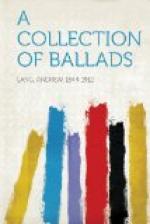A Liddesdale chant. Jock flourished about 1550-1570, and is commemorated as a receiver by Sir Richard Maitland in a poem often quoted. The analogies of this ballad with that of “Kinmont Willie” are very close. The reference to a punch-bowl sounds modern, and the tale is much less plausible than that of “Kinmont Willie,” which, however, bears a few obvious marks of Sir Walter’s own hand. A sceptical editor must choose between two theories: either Scott of Satchells founded his account of the affair of “Kinmont Willie” on a pre-existing ballad of that name, or the ballad printed by Scott is based on the prose narrative of Scott of Satchells. The former hypothesis, everything considered, is the more probable.
LORD THOMAS AND FAIR ANNET
Published in Percy’s Reliques, from a Scotch manuscript, “with some corrections.” The situation, with various differences in detail and conclusion, is popular in Norse and Romaic ballads, and also in many Marchen of the type of The Black Bull of Norraway.
FAIR ANNIE
From The Border Minstrelsy. There are Danish, Swedish, Dutch, and German versions, and the theme enters artistic poetry as early as Marie de France (Le Lai del Freisne). In Scotch the Earl of Wemyss is a recent importation: the earldom dates from 1633. Of course this process of attaching a legend or Marchen to a well-known name, or place, is one of the most common in mythological evolution, and by itself invalidates the theory which would explain myths by a philological analysis of the proper names in the tale. These may not be, and probably are not, the original names.
THE DOWNIE DENS OF YARROW
From The Border Minstrelsy. Scott thought that the hero was Walter Scott, third son of Thirlestane, slain by Scott of Tushielaw. The “monument” (a standing stone near Yarrow) is really of a very early, rather Post-Roman date, and refers to no feud of Thirlestane, Oakwood, Kirkhope, or Tushielaw. The stone is not far from Yarrow Krik, near a place called Warrior’s Rest. Hamilton of Bangour’s version is beautiful and well known. Quite recently a very early interment of a corpse, in the curved position, was discovered not far from the standing stone with the inscription. Ballad, stone, and interment may all be distinct and separate.
SIR ROLAND
From Motherwell’s Minstrelsy. The authenticity of the ballad is dubious, but, if a forgery, it is a very skilled one for the early nineteenth century. Poets like Mr. Swinburne, Mr. Rossetti, and Mrs. Marriot Watson have imitated the genuine popular ballad, but never so closely as the author of “Sir Roland.”
ROSE THE RED AND WHITE LILY
From the Jamieson-Brown Ms., originally written out by Mrs. Brown in 1783: Sir Waiter made changes in The Border Minstrelsy. The ballad is clearly a composite affair. Robert Chambers regarded Mrs. Brown as the Mrs. Harris of ballad lore, but Mr. Norval Clyne’s reply was absolutely crushing and satisfactory.




